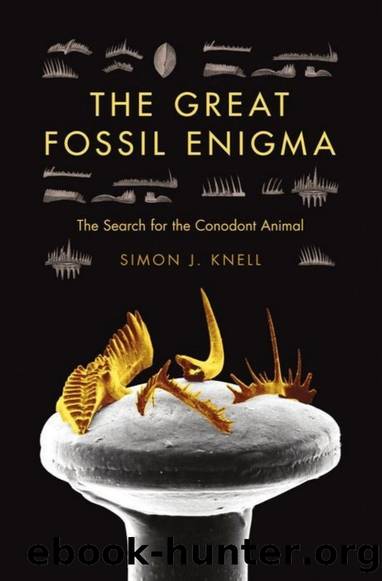The Great Fossil Enigma: The Search for the Conodont Animal by Simon J. Knell

Author:Simon J. Knell [Knell, Simon J.]
Language: eng
Format: epub
ISBN: 9780253006066
Google: VWTgEwhLpjAC
Amazon: 0253006066
Barnesnoble: 0253006066
Goodreads: 16462158
Publisher: Indiana University Press
Published: 0101-01-01T00:00:00+00:00
The 1980 asteroid, or meteorite, that once struck earth and now, in a metaphorical sense, impacted the scientific community was delivered by Nobel laureate physicist Luis Alvarez and his geologist son, Walter, along with chemists Frank Asao and Helen Michel. It arose from work Walter Alvarez had been conducting at the Cretaceous-Tertiary boundary at the ancient town of Gubbio in Umbria, Italy. Measuring the trace element iridium, which is constantly falling to Earth as meteoric dust, he postulated that its degree of dilution in marine sediments would indicate how rapidly the sediment had been deposited. The sedimentary dilution of a constant â such as Merrillâs dying and fossilized animals, discussed in the previous chapter, or meteoric dust falling to Earth â had long been used to deduce the relative rates at which rocks were laid down. The sediment that interested Alvarez marked the end of the Cretaceous, that remarkable moment when the dinosaurs and many other kinds of animal became extinct. However, it was not dinosaurs that first caused Alvarez to stop and think, but the near extinction of those tiny amoeba-like animals with delicate and intricate shells known as foraminifera. At Gubbio, a centimeter-thick layer of clay divides the extraordinarily different foraminifera of the Cretaceous from those of the overlying Tertiary. Alvarez asked, âHas this mass extinction occurred in a human timescale or a geological one?â In order to answer this question, he needed to know how rapidly the clay had been deposited.3
As it turned out, the iridium performed better than he had hoped, for rather than simply giving Alvarez the rapidity of change, it also gave him a cause. What he found were extraordinarily high amounts of this element (in relative terms at least). After much deliberation, the team felt this could only be explained by a huge meteorite impact. Astronomy, that esoteric science of other worlds too distant to really know, now became central to understanding the history of life on Earth. Newly globalized, geology now found itself a science of planets.
The idea was a âbombshellâ that caused an explosion of papers and conferences â and some bizarre theoretical imaginings, including a death star called Nemesis and an equally deadly Planet x. Supportive speculation and doubting cynicism developed in parallel, but increasing amounts and types of data seemed to confirm this radical and seemingly improbable alien visitor.4 The impact on science was so great that it is easy to imagine geologists now talking new talk and thinking thoughts that had never previously crossed their minds. But this was not entirely what happened. Their initial response was to work with what they knew, to marry this new idea with existing data. In this respect the asteroid became a new pair of interpretive spectacles through which to look afresh at old things. These glasses would also encourage geologists to seek out obscure and esoteric work that at one time seemed to make little sense. Perhaps it would do so now. In some cases, yesterdayâs nonsense and self-indulgence suddenly became prophetic.
Download
This site does not store any files on its server. We only index and link to content provided by other sites. Please contact the content providers to delete copyright contents if any and email us, we'll remove relevant links or contents immediately.
| Anatomy | Animals |
| Bacteriology | Biochemistry |
| Bioelectricity | Bioinformatics |
| Biology | Biophysics |
| Biotechnology | Botany |
| Ecology | Genetics |
| Paleontology | Plants |
| Taxonomic Classification | Zoology |
Sapiens: A Brief History of Humankind by Yuval Noah Harari(14321)
The Tidewater Tales by John Barth(12626)
Mastermind: How to Think Like Sherlock Holmes by Maria Konnikova(7278)
Do No Harm Stories of Life, Death and Brain Surgery by Henry Marsh(6905)
The Thirst by Nesbo Jo(6881)
Why We Sleep: Unlocking the Power of Sleep and Dreams by Matthew Walker(6657)
Life 3.0: Being Human in the Age of Artificial Intelligence by Tegmark Max(5516)
Sapiens by Yuval Noah Harari(5324)
The Longevity Diet by Valter Longo(5042)
The Body: A Guide for Occupants by Bill Bryson(5030)
The Rules Do Not Apply by Ariel Levy(4910)
The Immortal Life of Henrietta Lacks by Rebecca Skloot(4550)
Animal Frequency by Melissa Alvarez(4428)
Why We Sleep by Matthew Walker(4394)
The Hacking of the American Mind by Robert H. Lustig(4339)
Yoga Anatomy by Kaminoff Leslie(4333)
All Creatures Great and Small by James Herriot(4271)
Double Down (Diary of a Wimpy Kid Book 11) by Jeff Kinney(4241)
Embedded Programming with Modern C++ Cookbook by Igor Viarheichyk(4141)
